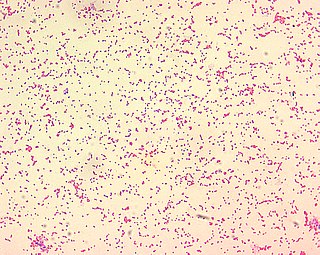
The Rhizobiaceae is a family of Pseudomonadota comprising multiple subgroups that enhance and hinder plant development. Some bacteria found in the family are used for plant nutrition and collectively make up the rhizobia. Other bacteria such as Agrobacterium tumefaciens and Rhizobium rhizogenes severely alter the development of plants in their ability to induce crown galls or hairy roots, respectively. The family has been of an interest to scientists for centuries in their ability to associate with plants and modify plant development. The Rhizobiaceae are, like all Pseudomonadota, Gram-negative. They are aerobic, and the cells are usually rod-shaped. Many species of the Rhizobiaceae are diazotrophs which are able to fix nitrogen and are symbiotic with plant roots.
The Phyllobacteriaceae are a family of bacteria. The most common genus is Mesorhizobium which contains some of the rhizobia species.

The Brucellaceae are a family of the Gram-negative Hyphomicrobiales. They are named after Sir David Bruce, a Scottish microbiologist. They are aerobic chemoorganotrophes. The family comprises pathogen and soil bacteria
The Eubacteriales are an order of bacteria placed within the class Clostridia.

Desulfovibrionales are a taxonomic order of bacteria belonging to the phylum Thermodesulfobacteriota, with four families. They are Gram-negative. The majority are sulfate-reducing, with the exception of Lawsonia and Bilophila. All members of this order are obligately anaerobic. Most species are mesophilic, but some are moderate thermophiles.
The Syntrophobacterales are an order of Thermodesulfobacteriota. All genera are strictly anaerobic. Many of the family Syntrophobacteraceae are sulfate-reducing. Some species are motile by using one polar flagellum.
Archaeoglobus is a genus of the phylum Euryarchaeota. Archaeoglobus can be found in high-temperature oil fields where they may contribute to oil field souring.

The Bifidobacteriaceae are the only family of bacteria in the order Bifidobacteriales. According to the 16S rRNA-based LTP release 106 published by 'The All-Species Living Tree' Project, the order Bifidobacteriales is a clade nested within the suborder Micrococcineae, also the genus Bifidobacterium is paraphyletic to the other genera within the family, i.e. the other genera are nested within Bifidobacterium.
The Halanaerobiales are an order of bacteria placed within the class Clostridia, and encompassing two families, the Halanaerobiaceae and the Halobacteroidaceae. Originally placed within the highly polyphyletic class Clostridia, according to the NCBI and LPSN, it is now thought to lie outside the Bacillota. Halanaerobiales are halophilic obligate anaerobes with a fermentative or homoacetogenic metabolism.

Alphaproteobacteria is a class of bacteria in the phylum Pseudomonadota. The Magnetococcales and Mariprofundales are considered basal or sister to the Alphaproteobacteria. The Alphaproteobacteria are highly diverse and possess few commonalities, but nevertheless share a common ancestor. Like all Proteobacteria, its members are gram-negative and some of its intracellular parasitic members lack peptidoglycan and are consequently gram variable.
Sphingobacteriaceae is a family of environmental bacteria.
The Nitrobacteraceae are a family of gram-negative, aerobic bacteria. They include plant-associated bacteria such as Bradyrhizobium, a genus of rhizobia associated with some legumes. It also contains animal-associated bacteria such as Afipia felis, formerly thought to cause cat-scratch disease. Others are free-living, such as Rhodopseudomonas, a purple bacterium found in marine water and soils. The strain Rhodopseudomonas palustris DX-1 can generate an electric current with no hydrogen production, a trait being explored in the development of the microbial fuel cell. The genus Afipia has also been found in the atmosphere, where it uses methylsulfonylmethane as a carbon source.

Atribacterota is a phylum of bacteria, which are common in anoxic sediments rich in methane. They are distributed worldwide and in some cases abundant in anaerobic marine sediments, geothermal springs, and oil deposits. Genetic analyzes suggest a heterotrophic metabolism that gives rise to fermentation products such as acetate, ethanol, and CO2. These products in turn can support methanogens within the sediment microbial community and explain the frequent occurrence of Atribacterota in methane-rich anoxic sediments. According to phylogenetic analysis, Atribacterota appears to be related to several thermophilic phyla within Terrabacteria or may be in the base of Gracilicutes. According to research, Atribacterota shows patterns of gene expressions which consists of fermentative, acetogenic metabolism. These expressions let Atribacterota to be able to create catabolic and anabolic functions which are necessary to generate cellular reproduction, even when the energy levels are limited due to the depletion of dissolved oxygen in the areas of sea waters, fresh waters, or ground waters.
Devosiaceae is a family of Alphaproteobacteria.
The Thalassospiraceae are a family of bacteria from the order Rhodospirillales.
The Stellaceae are a family of bacteria from the order Rhodospirillales.
Reyranella is a genus of bacteria from the order Rhodospirillales.
The Thalassobaculaceae are a family of bacteria from the order Rhodospirillales.
The Rhodovibrionaceae are a family of bacteria from the order Rhodospirillales.
The Propionibacteriales are an order of bacteria.






